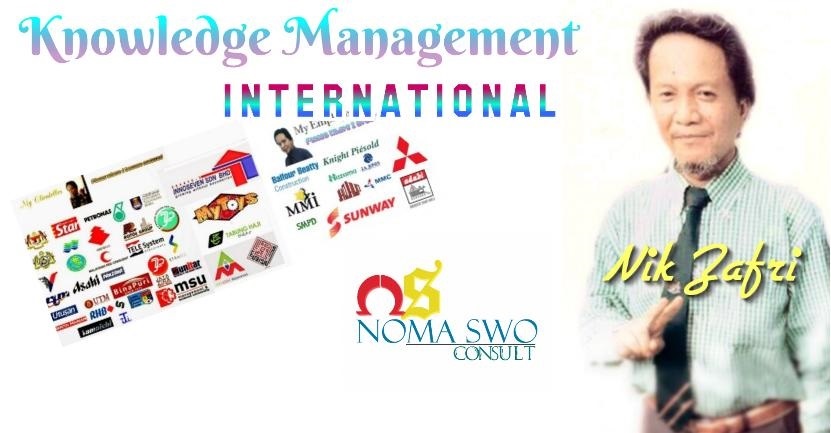DISCLAIMER - NIKZAFRI.BLOGSPOT.COM
In no event shall nikzafri.blogspot.com be liable for any damages whatsoever, including, without limitation, direct, special, indirect, consequential, or incidental damages, or damages for lost profits, loss of revenue, or loss of use, arising out of or related to the nikzafri.blogspot.com or the information contained in it, whether such damages arise in contract, negligence, tort, under statute, in equity, at law or otherwise.
BIODATA - NIK ZAFRI

Kelantanese, Alumni of Sultan Ismail College Kelantan (SICA), IT Competency Cert, Certified Written English Professional US. Has participated in many seminars/conferences (local/ international) in the capacity of trainer/lecturer and participant.
Affiliations :- Network Member of Gerson Lehrman Group, Institute of Quality Malaysia, Auditor ISO 9000 IRCAUK, Auditor OHSMS (SIRIM and STS) /EMS ISO 14000 and Construction Quality Assessment System CONQUAS, CIDB (Now BCA) Singapore),
* Possesses almost 30 years of experience/hands-on in the multi-modern management & technical disciplines (systems & methodologies) such as Knowledge Management (Hi-Impact Management/ICT Solutions), Quality (TQM/ISO), Safety Health Environment, Civil & Building (Construction), Manufacturing, Motivation & Team Building, HR, Marketing/Branding, Business Process Reengineering, Economy/Stock Market, Contracts/Project Management, Finance & Banking, etc. He was employed to international bluechips involving in national/international megaprojects such as Balfour Beatty Construction/Knight Piesold & Partners UK, MMI Insurance Group Australia, Hazama Corporation (Hazamagumi) Japan (with Mitsubishi Corporation, JA Jones US, MMCE and Ho-Hup) and Sunway Construction Berhad (The Sunway Group of Companies). Among major projects undertaken : Pergau Hydro Electric Project, KLCC Petronas Twin Towers, LRT Tunnelling, KLIA, Petronas Refineries Melaka, Putrajaya Government Complex, Sistem Lingkaran Lebuhraya Kajang (SILK), Mex Highway, KLIA1, KLIA2 etc. Once serviced SMPD Management Consultants as Associate Consultant cum Lecturer for Diploma in Management, Institute of Supervisory Management UK/SMPD JV. Currently – Associate/Visiting Consultants/Facilitators, Advisors for leading consulting firms (local and international) including project management. To name a few – Noma SWO Consult, Amiosh Resources, Timur West Consultant Sdn. Bhd., TIJ Consultants Group (Malaysia and Singapore) and many others.
* Ex-Resident Weekly Columnist of Utusan Malaysia (1995-1998) and have produced more than 100 articles related to ISO-9000– Management System and Documentation Models, TQM Strategic Management, Occupational Safety and Health (now OHSAS 18000) and Environmental Management Systems ISO 14000. His write-ups/experience has assisted many students/researchers alike in module developments based on competency or academics and completion of many theses. Once commended by the then Chief Secretary to the Government of Malaysia for his diligence in promoting and training the civil services (government sector) based on “Total Quality Management and Quality Management System ISO-9000 in Malaysian Civil Service – Paradigm Shift Scalar for Assessment System”
Among Nik Zafri’s clients : Adabi Consumer Industries Sdn. Bhd, (MRP II, Accounts/Credit Control) The HQ of Royal Customs and Excise Malaysia (ISO 9000), Veterinary Services Dept. Negeri Sembilan (ISO 9000), The Institution of Engineers Malaysia (Aspects of Project Management – KLCC construction), Corporate HQ of RHB (Peter Drucker's MBO/KRA), NEC Semiconductor - Klang Selangor (Productivity Management), Prime Minister’s Department Malaysia (ISO 9000), State Secretarial Office Negeri Sembilan (ISO 9000), Hidrological Department KL (ISO 9000), Asahi Kluang Johor(System Audit, Management/Supervisory Development), Tunku Mahmood (2) Primary School Kluang Johor (ISO 9000), Consortium PANZANA (HSSE 3rd Party Audit), Lecturer for Information Technology Training Centre (ITTC) – Authorised Training Center (ATC) – University of Technology Malaysia (UTM) Kluang Branch Johor, Kluang General Hospital Johor (Management/Supervision Development, Office Technology/Administration, ISO 9000 & Construction Management), Kahang Timur Secondary School Johor (ISO 9000), Sultan Abdul Jalil Secondary School Kluang Johor (Islamic Motivation and Team Building), Guocera Tiles Industries Kluang Johor (EMS ISO 14000), MNE Construction (M) Sdn. Bhd. Kota Tinggi Johor (ISO 9000 – Construction), UITM Shah Alam Selangor (Knowledge Management/Knowledge Based Economy /TQM), Telesystem Electronics/Digico Cable(ODM/OEM for Astro – ISO 9000), Sungai Long Industries Sdn. Bhd. (Bina Puri Group) - ISO 9000 Construction), Secura Security Printing Sdn. Bhd,(ISO 9000 – Security Printing) ROTOL AMS Bumi Sdn. Bhd & ROTOL Architectural Services Sdn. Bhd. (ROTOL Group) – ISO 9000 –Architecture, Bond M & E (KL) Sdn. Bhd. (ISO 9000 – Construction/M & E), Skyline Telco (M) Sdn. Bhd. (Knowledge Management),Technochase Sdn. Bhd JB (ISO 9000 – Construction), Institut Kefahaman Islam Malaysia (IKIM – ISO 9000 & Internal Audit Refresher), Shinryo/Steamline Consortium (Petronas/OGP Power Co-Generation Plant Melaka – Construction Management and Safety, Health, Environment), Hospital Universiti Kebangsaan Malaysia (Negotiation Skills), Association for Retired Intelligence Operatives of Malaysia (Cyber Security – Arpa/NSFUsenet, Cobit, Till, ISO/IEC ISMS 27000 for Law/Enforcement/Military), T.Yamaichi Corp. (M) Sdn. Bhd. (EMS ISO 14000) LSB Manufacturing Solutions Sdn. Bhd., (Lean Scoreboard (including a full development of System-Software-Application - MSC Malaysia & Six Sigma) PJZ Marine Services Sdn. Bhd., (Safety Management Systems and Internal Audit based on International Marine Organization Standards) UNITAR/UNTEC (Degree in Accountacy – Career Path/Roadmap) Cobrain Holdings Sdn. Bhd.(Managing Construction Safety & Health), Speaker for International Finance & Management Strategy (Closed Conference), Pembinaan Jaya Zira Sdn. Bhd. (ISO 9001:2008-Internal Audit for Construction Industry & Overview of version 2015), Straits Consulting Engineers Sdn. Bhd. (Full Integrated Management System – ISO 9000, OHSAS 18000 (ISO 45000) and EMS ISO 14000 for Civil/Structural/Geotechnical Consulting), Malaysia Management & Science University (MSU – (Managing Business in an Organization), Innoseven Sdn. Bhd. (KVMRT Line 1 MSPR8 – Awareness and Internal Audit (Construction), ISO 9001:2008 and 2015 overview for the Construction Industry), Kemakmuran Sdn. Bhd. (KVMRT Line 1 - Signages/Wayfinding - Project Quality Plan and Construction Method Statement ), Lembaga Tabung Haji - Flood ERP, WNA Consultants - DID/JPS -Flood Risk Assessment and Management Plan - Prelim, Conceptual Design, Interim and Final Report etc., Tunnel Fire Safety - Fire Risk Assessment Report - Design Fire Scenario), Safety, Health and Environmental Management Plans leading construction/property companies/corporations in Malaysia, Timur West Consultant : Business Methodology and System, Information Security Management Systems (ISMS) ISO/IEC 27001:2013 for Majlis Bandaraya Petaling Jaya ISMS/Audit/Risk/ITP Technical Team, MPDT Capital Berhad - ISO 9001: 2015 - Consultancy, Construction, Project Rehabilitation, Desalination (first one in Malaysia to receive certification on trades such as Reverse Osmosis Seawater Desalination and Project Recovery/Rehabilitation)
* Has appeared for 10 consecutive series in “Good Morning Malaysia RTM TV1’ Corporate Talk Segment discussing on ISO 9000/14000 in various industries. For ICT, his inputs garnered from his expertise have successfully led to development of work-process e-enabling systems in the environments of intranet, portal and interactive web design especially for the construction and manufacturing. Some of the end products have won various competitions of innovativeness, quality, continual-improvements and construction industry award at national level. He has also in advisory capacity – involved in development and moderation of websites, portals and e-profiles for mainly corporate and private sectors, public figures etc. He is also one of the recipients for MOSTE Innovation for RFID use in Electronic Toll Collection in Malaysia.
Note :
Tuesday, December 05, 2023
CONDOLENCES TO THE FAMILY OF THE LATE FORMER HEALTH MINISTER, DATO' CHUA JUI MENG
In 1995, while I was employed by Mayjaus JV - Hazama Corporation (KLCC Petronas Towers during construction) and also a weekly-columnist for a national paper, I first encountered the late former Health Minister, Dato' Chua Jui Meng. During that time, I was meeting with Allahyarham Tun Ahmad Sarji, the then Chief Secretary to the Government of Malaysia, to delve deeper into implementing ISO 9000 in civil services.Subsequently, the newly appointed Health Minister asked me to join him and his assistant in a private discussion room. He was interested in hearing my perspectives on enhancing quality management in healthcare.
I remember opening the thick 6th Malaysian Plan - quoting the mid term review which read :
"While the government will still remain a provider of basic health services, the role of the Ministry of Health will gradually shifts towards more policymaking and regulatory aspects, as well as, setting standards to ensure quality, affordability and appropriateness of care. At the same time the Ministry of Health will ensure an equitable distribution in the provision of health services and health manpower between the public and private sectors"
I noticed a faint surprise on his face as he remarked, "You read that verse in the 6th Malaysian Plan? I don't even recall it."
With a chuckle, I replied, "I'm aware there's a quality standard based on TQM that the Ministry is already following, and it seems to be working well." (so why need the upgrade?)
However, the main concern at that time, perhaps, was the inevitable rise of Malaysian healthcare privatization. While the Health Ministry and its hospitals aimed to adhere to the standard, certain issues, such as the transition, raised questions about potential disparities in practice between the Health Ministry and private entities, the potential increase in medication expenses and the accessibility/affordability for the public at large.
I held the opinion that implementing privatization too soon might pose challenges in effectively enhancing the quality of healthcare systems due to potential differences in management approaches.
Reflecting on the government's decision at that time to put the privatization plan on hold, I silently speculated, "He (Chua) must have convinced the then Prime Minister, Tun Dr. Mahathir."
It's truly a loss. My deepest condolences go out to the family.
Sunday, August 20, 2023
THROWBACK 2016
Friday, March 17, 2017
TYPICAL PITFALLS IN CORPORATE GOVERNANCE - Nik Zafri
- "I'm your paymaster",
- "Make it looks like there is more "loss" than "profit",
- "I know your boss",
- "Don't try to be too smart - remember Enron?"
Saturday, October 24, 2015
THE NEW ISO 9001:2015 - NIK ZAFRI
Disclaimer : Most of the contents here are not the 'actual/literal' text of the actual new ISO 9001:2015. It's the personal interpretation of the author.
Definition
How to make everyone understand?
Mind you, I'm not talking about the typical (word by word) memorizing the policy or objectives – remember UNDERSTAND is totally different than MEMORIZE....
Yes, the new ISO 9001:2015 is attempting to cover and solve ALL kinds of management and technical problems (sound kind of ambitious - don't you think?) – however, lots of cross-referencing need to be made. Act smart for a while...please
Tuesday, June 16, 2015
VENDOR DEVELOPMENT PROGRAM (CONSTRUCTION INDUSTRY) - BY NIK ZAFRI
Monday, March 23, 2015
WORKSHOP-CONSTRUCTION QMS, INTERNAL AUDIT, DIS ISO 9001:2015 Overview
Final day - practical for (mock-up) internal audit for construction industry and overview of upgrading to (DIS) ISO 9001:2015 to include Risk Management.
Tuesday, February 17, 2015
ISO 9000 - TYPICAL DOCUMENTATION GUIDELINES (CONSTRUCTION) - NIK ZAFRI
It is highly advised that - further details on tailor-made/customized documentation development, workshops, conferences or training, please contact nikzafri@yahoo.com or nikzafri@gmail.com or fill up this enquiry form for RFQ






































